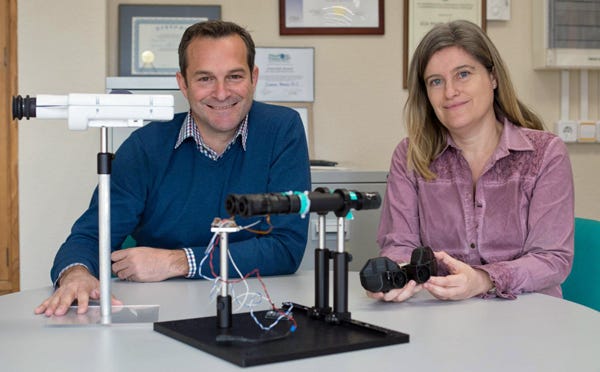New Device Simulates Vision for Cataract Patients
August 24, 2016
The device enables people with cataracts to preview how a new artificial lens will change their vision, before the lens is surgically implanted.
Kristopher Sturgis
|
Carlos Dorronsoro and Susana Marcos at the Institute of Optics (Madrid, Spain) have tested the monocular SimVis device. They're now working on a binocular version to simulate different types of lenses in each eye. (Image courtesy of Carlos Dorronsoro/Institute of Optics) |
Traditionally when patients need cataract surgery, an intraocular lens is surgically implanted into the eye to replace the patient's natural lens inside the eye that has become cloudy and obstructs vision. When it comes to selecting the appropriate lens for implantation, the decision is typically made by the surgeon based on the condition of the patient's lens. This often leaves patients in the dark when it comes to making a decision on surgery, and what lens is appropriate for their condition.
Spanish researchers, however, have now created a hand-held device called a simultaneous vision simulator, or SimVis, that enables patients to actually experience how different lenses would affect their vision simply by looking through the device.
Created at the Institute of Optics in Madrid, the SimVis uses an optoelectronic tunable lens that changes shape in response to an applied electric current, according to The Optical Society, which published the Spanish researchers' work in its journal Optica.
Over the last decade, lens companies have worked to design a variety of different lenses that can not only eliminate cloudiness, but also correct the patient's vision. Unfortunately, most implanted lenses are monofocal, meaning they bring objects far away into focus, but create blurred vision for objects close by. Recently multifocal lenses have been created to focus on both near and far objects, but they do come with some loss of image quality and contrast at both near and far distances.
This has resulted in a wider range of lens choices for patients needing cataract surgery, providing both monofocal and multifocal lens options for patients. Unfortunately, without any means to preview the differences between the various lenses before surgery, choosing the right lens can become somewhat of a guessing game. Using the new SimVis device, patients can now preview monofocal and multifocal lenses to better decide which lens suits their vision needs best.
Advances in ophthalmology have been rather eye opening lately as advancements in implants and lens technologies have driven vision therapies to new heights.
Earlier this year Google announced a smart eye implant device that could help treat a variety of conditions that reduce vision focus. Meanwhile in July, the FDA approved an intraocular lens known as the Tecnis Symfony IOL, a new lens technology that will provide patients suffering from cataracts with an extended depth-of-focus unlike any other lens on the market.
According to the National Eye Institute, roughly 24.4 million Americans had cataracts in 2010, and that number is expected to grow to 50.2 million by 2050. With the growing demand for cataract treatment options, the SimVis device could prove to be an important addition.
The latest version of the simulator looks like a virtual reality helmet, but researchers are working on a binocular version of the SimVis that is not only smaller, but will also simulate different lenses in each eye. Researchers are designing this new version to be lighter, and provide a wider field of view to make the preview for different lenses more clearer to the patient. The group remains hopeful that the necessary clinical evaluations for the binocular version of SimVis can be completed so the device can be commercially available by 2017.
Kristopher Sturgis is a contributor to Qmed.
Like what you're reading? Subscribe to our daily e-newsletter.
About the Author(s)
You May Also Like



